|
FAQs on Water Feature Repair
2
Related Articles: Pond
Repair Work, Liners for
Ponds,
Related FAQs: Water
Feature Repairs 1, Water Feature Repairs
3, More specifically: Leaks/Leaking, Seepage, Earthen
Pond Repairs, Waterfall
Repairs, Liner Repairs, Electrical Problems, Fountain Repairs, Faux Rock Repairs, Crack Repairs... & Foundation Coatings, Liner Pond Repairs, Liners in Pond
Construction,
|
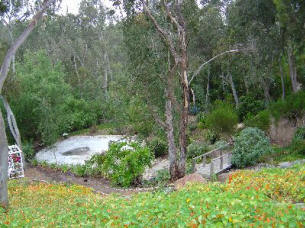
|
 |
Aquatic Gardens
Ponds, Streams, Waterfalls
& Fountains:
Volume 1. Design & Construction
Volume 2. Maintenance, Stocking, Examples
V. 1
Print and
eBook on Amazon
V. 2
Print and
eBook on Amazon
by Robert (Bob) Fenner |
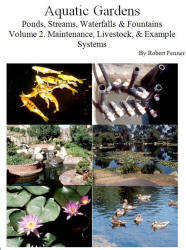 |
| Renovation of an Old Cement Pond - Let the Fun
Begin! Hi Bob- I am currently in the midst of renovating
/repairing an old and neglected cement pond. We recently moved to
San Diego, and the house had a large pond and waterfall that had
been severely neglected. We think it's about 38,000 gallons,
and the waterfall is probably 40ft long with at least two places
where the water will (eventually) come out. So, we've spent the
better part of this spring draining and cleaning the 2 1/2 feet of
pond sludge and overgrown aquatic plants. <Yuck, what a
project!> The pond is now completely clean and empty. There are
7 drains that I had Roto-rootered, and they are clear (as far as
I know). There is a large faux rock that houses the old
equipment (two waterfall motors, and a huge round filter(?) - maybe
an old swimming pool filter). There are several cracks in the
waterfall cement - and crushed faux rocks. I've been trying to
find someone (anyone) to repair these. <Mmm, maybe better or
even have to do yourself> I'm not planning on having many
fish (lots of predators in my neighborhood). I've had a couple
of outrageous quotes - pre- pond drain - but now I'm not sure
what to do. Aside from repairing the cracks - should I test the
current equipment? <Yes... unless you plan to carte blanche
replace it> I'm pretty sure I'll need a new filter and a
U.V. (whatever it's called). Anyway - someone put a lot of
thought into this pond many years ago, and I'm doing my best to
resurrect it, but I'm at a standstill. Any insight would be
great! Thanks ! Margot <Mmm, I live in San Diego, and worked on
many ponds here over the years... Where is this one exactly? You
should do a good bit of investigating re gear... as much has
changed over the years, especially the kwh cost of electricity...
and technology for pond keeping. Bob Fenner> |
|
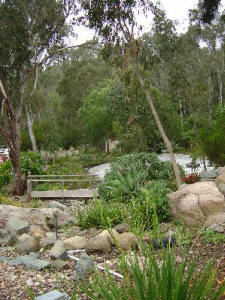 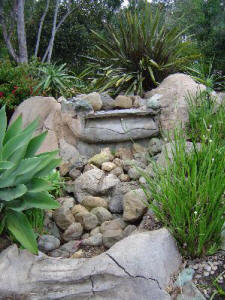
|
Waterfall repair question Mr. Fenner, <Mike> I read
your articles on pond repair and have a question on the
"other" materials that can be used to seal a
waterfall. I am in Hawaii so some materials are hard to come
by. <I know... we own a house mauka of Kona... and visit there
often> Our waterfall has two basins that spill into the swimming
pool. A liner was used but there is a lot of leaching (white
stuff, lime?) out of the grout joints between the rocks. <Mmm, you
might want to consider trying to effect a repair/change here...
acid-washing the area, letting it dry and coating the rock... there are
a few materials that can be used here> The top basin
drains down a good 6 inches overnight, mostly into the second basin
which drains (or should I say leaks) down an inch or
two. There is also a little area on one side where the
waterfall was going to have a side path that was eliminated, and water
leaks into that area Looks like it is probably following the liner into
that area after it leak through whatever crack or defect there is.
<Okay> The waterfall was built using a liner so we aren't
losing the water, just leaching/leaking it into the
pool. Over the liner was a base of concrete made from
Hawaiian cement (not plastic cement) and a fine crushed rock, the
consistency of coarse sand. Rocks were set on it
later. Then the contractor plastered the basins with a sand,
cement, and ad-mix mixture. <Good explanation> I
would like to replaster the basins to try and stop the
leaking. Is it o.k. to use this type of mixture or should I
try something else? <If it were mine, I'd likely make a mix of
plastic cement, sharp sand, oxide to color to something akin to the
rock and the aggregate... and a good dollop of admixture (looks like
white glue)... to make it stickier.> Do I need to acid wash before I
do this? <Yes, I definitely would... and of course let dry> What
is the white stuff leaching through the grouted joints? <Mainly
calcium carbonate... with some calcium oxide and silicate> Thanks
for you help, Mike <Welcome. Bob Fenner>
Locating, fixing concrete fountain leaks Gentlemen -
<Roger> My housing addition (located in Nashville, TN) has a
40,000 gallon decorative fountain with leaks and we desire to locate
these leaks. <... that's a fountain!> The fountains consist
of 3 pools connected by two channels and they vary in depth from 23
inches to 27 inches. The water is filtered by a large swimming pool
sand filter and is pumped into these pools by two 1.5 horsepower
electric pumps connected in series. There is one nozzle in the center
of each pool with the water projecting straight upward to 40 feet in
the large pool and 8 feet in the two smaller pools. The center pool is
50 feet in diameter and the two side pools are 25 feet in diameter. The
pools were built in 1987 with concrete blocks which are filled with
concrete and are set on top of poured concrete pads. Approx. 1/2 inch
of concrete paste was placed on the sides and bottom of each pool and
the two channels. The two channels are 3 feet wide and approx. 25 feet
long. We operate the fountains all year and have maintenance performed
weekly by a pool company which performs backwashing and adds chemicals
as required to keep the fountain water clear & clean all year. The
fountains are drained and cleaned 2 times/year. A "concrete
patch" was applied to areas that looked suspect about 5 years ago,
but is flaking off the sides and bottom at the moment. <All sounds
fine except the method of construction... even in a region of stable
geology, there are going to be cracks, leaks in such a structure>
The fountains are a great asset to our neighborhood and have given our
addition a beautiful feature. At the moment we are loosing approx.1,500
gallons/day and the city water bill is making them prohibitive to
operate. <And dangerous possibly... depending on where the water is
going, what it may be doing> We need advice as to what type of leak
maintenance should be performed and by whom. Roger Mishler, pool
maintenance coordinator <There are a few general steps you might
take here to render the basins leak-free... from various coatings that
can be applied by hand or machine, to applying a liner/membrane over
the existing structures and in essence, building a new shell inside the
current one... with wire and mortar of a few possible mixes, added
color... Without seeing this construct, I would opt for the most
conservative means here (the latter) as this will give you the most
secure, longest-lasting repair. Please see here re: http://www.wetwebmedia.com/PondSubWebIndex/concrepart.htm
and the Related Article and FAQs (linked, in blue, above). And feel
free to write me back if you have further questions, are looking for
more input. Our businesses effected several such repairs on basins of
your size... not fun, but necessary. Bob Fenner>
Help for leaking pond Hi We have a cement pond in
the yard which is starting to leak. There appears to some hairline
cracks in a few spots. We are looking for a solution to this problem. A
friend suggested spraying on rubberized truck bed liner to
stop leaks. Have you heard/tried this method of repair? <Not as of
yet... sounds like it could work... but kind of expensive as a
process> What is the easiest way do stop the leaks? Would a pond
liner solve this problem? Thanks, Steve <Have an article here:
http://wetwebmedia.com/PondSubWebIndex/concrepart.htm and the
Related FAQs (linked, in blue, at top)... that details steps of
consideration, steps to completion... IF the basin is stable, perhaps a
coating will do the trick... Bob Fenner>
Thorite source FLA Hi, I live in Nassau & wish to buy
some Thorite to patch some damaged concrete areas, can you advise a
suppler in the Miami area, thanks. Allan Winner.
<Try the search terms: Thoro products Florida Bob Fenner>
| Seeping pond help! Last year we dug this part
of the pond and had a liner in it. This year we added to
the size of the pond, removed the liner, and concreted the whole
thing. <I wish, and I bet you'll agree, that you'd just
added to the existing liner rather than remove it... This is the
proscribed method... and what we (our businesses used to fabricate
liners for this purpose, install them...> used to do.>
The small part is app. 3--3 1/2 feet deep. I
let the concrete cure, then I have put 2 thick coats of a masonry
waterproofing on, let cure for the recommended 2
weeks. I fill up this part, which in turn flows over the
side rocks into the larger part. When this is filled
(the small part), within 11-12 hours, the water has seeped down to
about 1 foot in the bottom. I can not find any active
leaks and do not know where the water is going. As you can see the
pond is dug in red clay as I live in East Texas where this type of
soil is pretty much predominant. <I'll trade with you for
our "soil" here in this part of Southern California...
which is about 1/3 clay, 1/3 boulders... and all back-breaking to
dig in... The leak problem... I would start with pressure-testing
your plumbing. Do you know how to do this? It might be more
economical to hire someone (likely in the swimming pool plumbing
biz) rather than buying your own test gear... Next, and maybe with
the same folks help, add a dye to the water, fill up the system and
use a colorimeter or more fancy spectrophotometer to try and detect
where the water is exiting... Do check around boulders that may
penetrate the apparent basins here (does the water slow or stop
seeping at some level?). At the very worst, do look into (posted on
www.WetWebMedia.com under the Pond Index/Section) how to effect a
repair of your current system with the placement, yes, of a liner
over the existing work. Good hunting! Bob Fenner> |
|
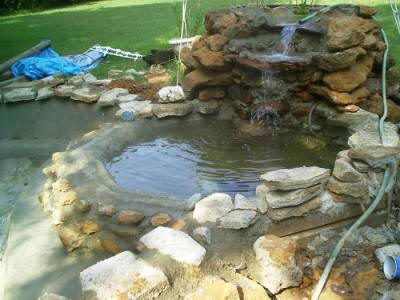
|
 |
Aquatic Gardens
Ponds, Streams, Waterfalls
& Fountains:
Volume 1. Design & Construction
Volume 2. Maintenance, Stocking, Examples
V. 1
Print and
eBook on Amazon
V. 2
Print and
eBook on Amazon
by Robert (Bob) Fenner |
 |
|
|

